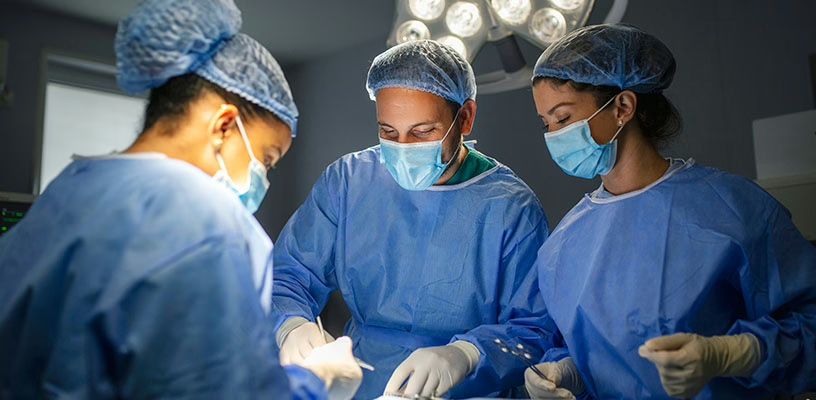C-Section (Cesarean Section): Procedure and Recovery
Labor is an intense experience, and unfortunately, things might not go exactly as you planned. If certain complications arise, it’s possible you’ll need a Cesarean section (C-section).

Although the thought of a C-section can be scary, you can rest assured that it’s usually a safe procedure, and it’s more common than you may think. In the US, nearly one-third of all babies were delivered by C-section in 2023. 1
To put your mind at rest, here’s everything you need to know about having a C-section, from preparing for the procedure to the recovery process.
What is a C-section?
A Cesarean section, commonly referred to as a C-section, is a surgical procedure where a doctor delivers your baby through incisions in your abdomen and uterus. They will usually only perform a C-section if they think it’s the safest option for you and your baby.
During a C-section, your doctor may use one of two types of incisions: 2
- A vertical cut, from your belly button down to your pubic hairline
- A horizontal cut across your pubic hairline
The exact type of incision your doctor will use in your procedure depends on your health and your baby’s, but a horizontal cut is more common because it heals better and usually results in less bleeding.
Why you might need a C-section
Your doctor will either plan a C-section in advance or perform one after labor has already started.
Reasons for a planned C-section
You may need a planned C-section if your doctor identifies any conditions that will make vaginal delivery too risky, like if you have chronic issues like unstable heart disease, high blood pressure (e.g., preeclampsia), or diabetes.
Other (relatively common) reasons your doctor may opt for a C-section include:
- A previous C-section: If you’ve had a C-section before—or any other surgeries to your uterus—another C-section might be the safest option. That said, some women can have a vaginal birth after a C-section (VBAC), so speak with your doctor to see if that will be possible.
- STDs/STIs: If you have an active genital herpes outbreak or an uncontrolled HIV infection, a C-section will prevent you from transmitting the virus to your baby during delivery.
- Problems with the placenta: Complications like placenta previa, where your placenta covers the cervix, can result in severe bleeding during a vaginal birth, making a C-section the safest way to deliver.
- Your baby’s position or size: A C-section will often be the safest route if your baby is in a breech (feet-first) or transverse (sideways) position and can’t be turned, or he’s very large (a condition called macrosomia). 3
- Carrying multiples: You’re more likely to need a C-section if you’re carrying multiples, especially if one or more of your babies aren’t in a head-down position.
Reasons for an unplanned C-section
Sometimes, a C-section unexpectedly becomes necessary once labor has already begun, usually if there’s a complication.
For instance, if your baby isn’t moving through your birth canal, no matter how much you push, or if your cervix stops opening (dilating), your medical team will need to quickly switch to a C-section. 4
Your medical team may also need to switch to a C-section delivery if:
- Your baby is in distress: If your baby’s heart rate becomes concerning or he shows signs of not getting enough oxygen, you may need an immediate delivery via C-section.
- There are issues with the umbilical cord: In rare cases, the umbilical cord can get caught between your pelvis and your baby’s head, or it may slip out of your cervix before he does (prolapsed cord).
- Your uterine wall ruptures: A tear in your uterine wall is a rare but serious emergency that will require an immediate C-section.
Your doctor and medical team will keep a close eye on you throughout labor, and if you need to switch to a C-section delivery, they’ll make sure you stay safe and as comfortable as possible.
Step-by-step guide to the C-section procedure
Whether your C-section is scheduled or happens unexpectedly, the good news is that most procedures are safe and relatively quick. The whole surgery typically lasts about 45 minutes to an hour. 5
Here’s what you can expect on the big day: 2
Preparation and anesthesia
First, you’ll need to get into a hospital gown, then a nurse will place an IV in your arm to provide fluids and medication. They’ll insert a catheter into your bladder to keep it empty during the surgery. Your doctor will clean your abdomen with an antiseptic solution and may strap your legs to the table for safety.
All of the above is assuming your surgery was planned; if it’s unexpected, the doctors may need to help you do this prep work much more quickly.
Most doctors will use a regional anesthesia for C-sections, like an epidural or a spinal block. This will numb the lower half of your body, but you’ll still be awake and alert for the birth.
If you have an emergency C-section, your doctor may use general anesthesia instead, which means you’ll be asleep for the procedure. Once you’re prepped, your partner or support person can join you and sit by your head.
Incision and delivery
Your medical team will place a screen across your chest so you can’t see the surgery. The surgeon will then make a small incision in your abdomen and then a second incision in your uterus.
You probably won’t feel any pain, but many women feel tugging or pulling sensations in their abdomens when their baby is pulled out.
Meeting your baby
After your baby is born, your medical team will clear any fluid from his mouth and nose and cut the umbilical cord. If you choose to, you can start breastfeeding your baby after this.
Closing the incision
While you hold your baby, the surgeon will deliver the placenta and then carefully close the incisions in your uterus and abdomen with stitches or staples. The medical team will then move you to a recovery room, where they’ll monitor you as the anesthesia wears off.
Do you need a birth plan for a C-section?
You can and should still have a birth plan, even if you know you’ll get a C-section. While each hospital’s policies vary, having a C-section doesn’t mean you won’t be able to personalize your experience.
Look into gentle C-sections
A “gentle C-section” aims to make the surgical birth experience feel less clinical and more like a traditional birth.
Your medical team may be able to use a clear drape (or lower an opaque one) when your baby is born so you can witness his first moments. You may also be able to have music playing in the operating room during labor.
If you’d like to personalize your C-section experience further, you can also ask about: 6
- Your support person’s role: Confirm where your partner or support person will be and if they can cut the umbilical cord.
- Immediate bonding: You can request to have skin-to-skin contact with your baby and breastfeed him immediately after he’s born, so long as both of you are stable.
- Newborn procedures: Go over your preferences for the standard post-birth procedures, like your baby’s vitamin K shot, eye ointment, his first bath, or any other health-related matters your doctor needs to tend to before your baby turns one week old. 7
Don’t be shy about speaking with your doctor about any other “gentle” approaches you’d like them to take during your C-section.
Can you have an elective C-section?
It is possible to request a C-section. It’s estimated that 2.5% of women opt for a C-section over a vaginal birth. This is known as Cesarean delivery on maternal request. 8
But while it is possible to choose a C-section, it’s usually better to opt for a natural vaginal birth, since a C-section does carry slightly more risks for you and your baby (more on this later).
Unless your doctor identifies a reason that necessitates a C-section, you should be able to safely give birth vaginally. 5
Are there risks with a C-section?
While a C-section is one of the safest and most common surgical procedures worldwide, it’s still a major abdominal surgery. As with any operation, there are risks for both you and your baby.
Potential risks for the mother
One of the biggest potential risks from the procedure is infection, which can happen in your C-section scar or even within your uterus (known as endometritis). The risk of this is around 15%. 9
You may also be at risk of: 10
- Hemorrhage (1%–7%)
- Pulmonary embolism (0.08%)
- Surgical injuries (0.5%)
It’s also possible you’ll have an adverse reaction to the anesthesia used for the procedure.
Future pregnancies can implant in C-section scars
Having a C-section puts you at a higher risk of having an ectopic pregnancy in the future. This is when a fertilized egg implants itself outside of the uterus. While this more commonly occurs in your fallopian tube, you could have an ectopic pregnancy in the scar of a previous C-section. 11
Potential risks for your baby
Babies born by C-section are more at risk of transient tachypnea of the newborn (TTN), a rapid breathing condition caused by leftover fluid in the lungs. Fortunately, TTN usually only lasts two days, and it won’t necessarily put your baby at risk of future breathing difficulties. 12
While it’s very unlikely, with a C-section, your baby is also a little more at risk of getting injured (generally lacerated, i.e., cut) during delivery.
Are C-sections more painful than vaginal births?
Both C-sections and vaginal births can be painful, but the pain tends to be worse at different points. With vaginal births, most of the pain happens during delivery. Conversely, you’ll be under anesthesia during a C-section, so you won’t feel any pain during the procedure.
However, the postpartum period of a C-section is when most women start feeling pain as a result of their incision healing. 5
How long does it take to recover from a C-section?
Recovering from a C-section often takes more time and care than with a vaginal birth. Along with the adjustments you’ll have to make to life with a newborn, you’ll also be healing from major surgery. It may take about 4–6 weeks for you to fully recover. 13
What happens right after a C-section?
After a C-section, you’ll probably need to stay in the hospital for about 2–3 days. During this time, your medical team will keep an eye on you and provide medication to manage your pain.
As soon as you’re able to, your nurses will encourage you to start moving, as this can prevent blood clots, ease your pain, and speed up your overall recovery. Your nurses will also show you how to keep your incision clean and spot the signs of an infection.
Tips for a smoother C-section recovery at home
Your recovery doesn’t stop the moment you leave the hospital. Your top priority is to rest as much as possible. In addition to healing from surgery, you’ll be dealing with many of the same postpartum symptoms as those who gave birth vaginally, like fatigue, hormonal shifts, and postpartum bleeding (lochia).
It’ll typically take about four to six weeks for your scar to heal, so during this time, take a step back and give your body the time it needs. Don’t be afraid to lean on your support network if you need them.
To ensure that your recovery continues smoothly, you should also: 14 13
- Protect your incision: Keep the area around your scar clean and dry, and wear loose, comfy clothes that won’t rub against it. When you cuddle or nurse your baby, try placing a pillow over your abdomen to cushion the area around your incision.
- Avoid intense physical activity: While a little moderate exercise can be beneficial for your postpartum recovery, you should avoid overly strenuous activities like taking too many steps or lifting heavy objects.
- Not rush into sex: Having sex after a C-section can be a little complicated. Generally, doctors advise waiting until about 6 weeks after a C-section before having sex again, or until you’re no longer bleeding from your vagina, to reduce the chances of infection. 14
- Manage your pain: Continue taking the pain medication prescribed by your doctor. If you’re breastfeeding, your doctor will prescribe medication that’s safe for your baby.
You may also be unable to drive for around 2–6 weeks after a C-section, especially if you’re taking narcotic pain medication or are feeling very weak. 15
Even if you feel fine, you might still have to check with your insurance company about their policy on driving after a C-section. 14
When to call your doctor after a C-section
Throughout your healing process, keep a close eye on your body for any signs of infection. Contact your doctor immediately if: 14
- You have a fever higher than 100.4°F (38°C)
- Your wound becomes increasingly red, swells, is warm, or has pus-like discharge
- You just feel generally unwell
Alongside these signs of infection, you should also let your doctor know if you have any general postpartum complications, such as foul-smelling vaginal discharge, heavy vaginal bleeding, or the symptoms of a blood clot in your legs, like redness or swelling.
Final thoughts
Whether it’s planned or unplanned, a C-section is sometimes the safest way of delivering your baby. The recovery can be challenging, but your doctor and medical team will be on hand to assist you in your recuperation.
Article Sources
- National Center for Health Statistics. "Births – Method of Delivery" Retrieved June 17, 2025.
- Johns Hopkins. "Cesarean Section" Retrieved June 17, 2025.
- Cleveland Clinic. "Fetal Macrosomia" Retrieved June 17, 2025.
- American College of Obstetricians and Gynecologists. "What to Know About Unplanned Cesarean Births" Retrieved June 17, 2025.
- The Mother Baby Center. "C-section vs. vaginal birth: the difference and which is best for you" Retrieved June 17, 2025.
- The University of Texas Southwestern Medical Center. "‘Gentle C-sections’: Bringing a traditional birth experience to the OR" Retrieved June 17, 2025.
- American Academy of Pediatrics. "Why Your Newborn Needs a Vitamin K Shot" Retrieved June 17, 2025.
- American College of Obstetricians and Gynecologists. "Cesarean Delivery on Maternal Request" Retrieved June 17, 2025.
- American Journal of Obstetrics and Gynecology. "Endometritis following cesarean section. A controlled study of the increased duration of hospital stay and direct cost of hospitalization" Retrieved June 17, 2025.
- Tommy’s. "C-section (caesarean) - benefits and risks" Retrieved June 17, 2025.
- The University of Texas Southwestern Medical Center. "Cesarean scar ectopic pregnancy: Facts and treatment options" Retrieved June 17, 2025.
- Boston Children’s Hospital. "Transient Tachypnea of the Newborn (TTN)" Retrieved June 17, 2025.
- Cleveland Clinic. "C-Section" Retrieved June 17, 2025.
- Tommy’s. "How to recover from a c-section (caesarean) at home" Retrieved June 17, 2025.
- Mount Sinai. "Going home after a C-section" Retrieved June 17, 2025.







